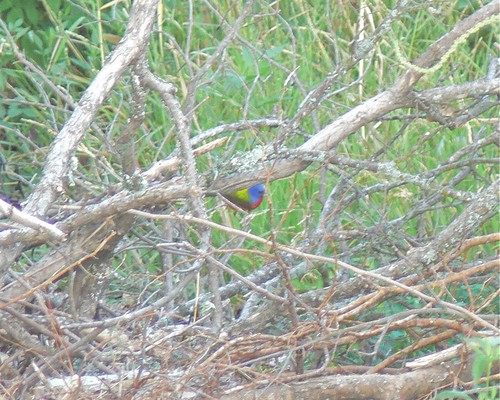Despite drought and record-breaking high temperatures in Austin, yearly bird life cycles continue. For many summer- and year-round-resident birds, breeding season is in its late stages. And for some, south-bound migration has already started! I spent 3 hours on Lake Creek Trail this morning and saw evidence of both. There are many new birds out of their nests and nearly fully grown now, and most parent birds aren't restricted to incubating eggs or feeding nestlings anymore. So I'm seeing higher numbers of neighborhood breeding species like Western Kingbirds, Barn Swallows, Killdeer, White-winged Doves, hummingbirds, Chimney Swifts, House Finches, and House Sparrows. Here's one of 15 Western Kingbirds I saw on the trail this morning.
Three species that breed in central Texas but probably don't breed in the neighborhood are Blue-gray Gnatcatchers, Painted Buntings, and Orchard Orioles. I found a few Blue-gray Gnatcatchers and Painted Buntings on the trail today. These might be young birds dispersing away from their parents' breeding territories and looking for new suitable habitat before migrating south. These also might be adult birds that are finished breeding and are no longer staying in their breeding territories. Here's one poor photo I got of a male Painted Bunting. (A good photo of a mature male in the neighborhood has eluded me so far. But at least you can see the colors.)
Orchard Orioles are already headed south, and some are already being reported in the Austin area. I might have seen one this morning. A small bird with a relatively long tail appeared making blackbird-like chucking calls. But the sun was behind it and all I could see was a silhouette. It could have been a Red-winged Blackbird or cowbird.
Many American shorebirds are migratory and start heading south through central Texas in middle and late July, so I was hoping to find a few on our creek this morning besides the ubiquitous Killdeer. I had almost given up hope when I finally found 3 Least Sandpipers and 2 Solitary Sandpipers just upstream of the dam near the end of Saddlebrook Trail. Both of these species breed in the boreal forests of Canada and Alaska. Least Sandpipers have an extremely broad winter range that includes northern South America and central Texas! They actually winter on our creek and can commonly be found on it during spring and fall migration. So June is just about the only month of the year Least Sandpipers are absent from the neighborhood. Here are the three that are on their way south.
Here's a list of the 43 species I found on the trail this morning. Don't let the heat keep you indoors. And hey, the temperature's not too high the first few hours after dawn!
You might have noticed that my posts here have decreased in frequency. I'll tell you more about that soon, but I have no plans to abandon this blog. Even though I'm not birding the neighborhood as often these days, I'm still dedicated to local birding and nature observation.




No comments:
Post a Comment